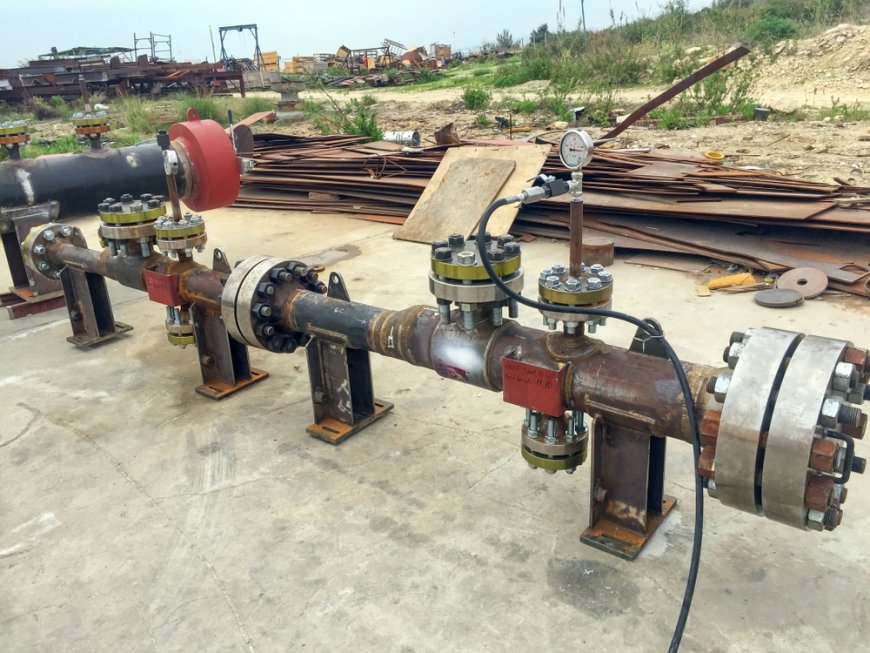What's Hydrostatic Testing
Hydrotesting in UAE is crucial for maintaining the structural integrity of industrial equipment. Let's look into what hydrostatic testing is, the methods used, and why it's so essential, especially in an industrial hub like the UAE.

Introduction
You are driving through the busy roads of Dubai or Abu Dhabi and you see the sprawling infrastructure around you, the pipelines transporting water and oil, and the storage tanks standing tall. Ever wondered how these critical components are tested for safety and durability? This is where hydrostatic testing, commonly known as hydrotesting comes into play.
Hydrotesting in UAE is crucial for maintaining the structural integrity of industrial equipment. Let's look into what hydrostatic testing is, the methods used, and why it's so essential, especially in an industrial hub like the UAE.
WHAT IS HYDROSTATIC TESTING ?
Hydrostatic testing is a method used to check the strength and leak-tightness of pressure vessels, pipelines, gas cylinders, and storage tanks. It involves filling the item with water, pressurizing it to a specified level, and then checking for leaks or structural integrity. This makes sure that the equipment can withstand its operational pressures without failure.
Hydrotesting is vital in various industries such as oil and gas, chemical processing, and water treatment. In the UAE, with its extensive network of pipelines and storage facilities, hydrostatic testing plays a significant role in preventing accidents and ensuring smooth operations.
COMMON HYDROSTATIC TESTING METHODS
There are several methods of hydrostatic testing, each suited to different types of equipment and testing requirements. Let us explore the three most common methods used in hydrotesting :
-
Water Jacket Method : In the water jacket method, the vessel to be tested is placed inside a sealed chamber filled with water. The vessel is then pressurized, causing it to expand. The water displaced by the expansion is measured, allowing technicians to determine if the vessel has any permanent deformation. This method is highly accurate and commonly used for testing gas cylinders and smaller pressure vessels.
-
Direct expansion method : The direct expansion method involves filling the vessel directly with water and pressurizing it. The amount of water that enters the vessel under pressure is measured, and any expansion is noted. This method is simpler than the water jacket method and is often used for larger vessels and pipelines. It provides a clear indication of the vessel's ability to handle pressure.
-
Proof Pressure Method : The proof pressure method applies a specific pressure to the vessel without measuring the expansion. It checks for immediate leaks or structural failures, making sure that the vessel can handle its designated pressure. This method is quick and effective for routine checks but doesn't provide as detailed information as the other methods.
WHY IS HYDROSTATIC TESTING IMPORTANT ?
Hydrostatic testing is crucial for several reasons, particularly in regions like the UAE where industrial safety and efficiency are paramount.
-
Ensuring safety : One of the primary reasons for hydrotesting is safety. By testing pressure vessels and pipelines, we can ensure they won’t fail under operational pressures, preventing catastrophic failures that could lead to accidents, environmental damage, and loss of life. In the oil and gas industry, for example, a pipeline rupture can have devasting consequences. Hydrotesting helps mitigate these risks by identifying weaknesses before they become issues.
-
Maintaining Compliance : Hydrotesting ensures that equipment meets regulatory standards and industry guidelines. In the UAE, adhering to these standards is essential for legal compliance and maintaining the reputation of businesses. Regular hydrostatic testing helps companies avoid fines, legal issues, and operational shutdowns due to non-compliance.
-
Enhancing Durability : Hydrostatic testing also contributes to the longevity of equipment. By identifying and addressing potential issues early, maintenance can be carried out proactively, extending the life of pressure vessels and pipelines. This is particularly important in the UAE, where the harsh environmental conditions can accelerate wear and tear on industrial equipment.
-
Protecting Investments : For businesses in the UAE, investing in industrial equipment is a significant expense. Hydrostatic testing protects this investment by ensuring that the equipment is fit for purpose and won't fail prematurely. This not only saves money on repairs and replacements but also minimizes downtime, making sure continuous and efficient operations.
Conclusion
Hydrostatic testing is an essential practice for making sure the safety, compliance, durability, and reliability of industrial equipment in the UAE. Whether you are in the Oil and gas sector, chemical processing, or water treatment, incorporating regular hydrotesting into your maintenance routine is crucial. Hydrotesting in UAE is not just a regulatory requirement; it is a commitment to safety and excellence. Make the smart choice and protect your business with Cortec® today.












